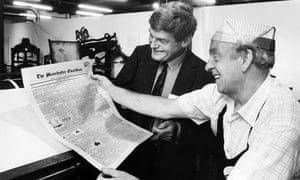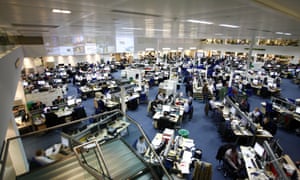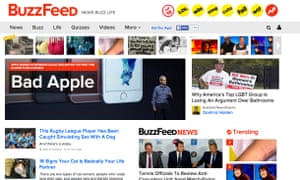Extract from The Guardian
Reflecting on my long experience in the newspaper business only reminds me that the rules are always being rewritten
Peter Preston, when editor of the Guardian, watches an archive copy of the paper come off an ancient press. Photograph: The Guardian
Sunday 1 January 2017 18.00 AEDT
The trouble as 2017 begins is simplicity, as in simple cause and effect. Fifteen years ago, Britain devoured around 15m newspapers each morning. Now it’s 6m and falling. Meanwhile digital consumption/addiction accelerates away and social media dominate reading time and attention.
One habit dies; another takes over. That’s an obvious tale of cause and effect, a conclusion that broadcasters who don’t much appreciate the printed press find an easy recitation. One habit falls, another takes over. An equation so basic you don’t really have to think about it – nor try to set it in any historical context. But look back awhile before you look forward. For looking forward means looking back.
History has a way of answering questions – and my history in print began almost six decades ago at the Witney Press, 12 miles from Oxford. There, twice a week, academic ambitions pushed conveniently well to one side, some of us brought out the university paper Cherwell. And there, too, we registered the hard, creaky truths about newspaper production: an old, thumping flatbed press down below, a composing room that shook as the first copies emerged, and three men who knew the ropes. Bill sat at the Linotype keyboard and set every word; George was head printer and head of everything; and then there was Trembly Charlie, who had a disconcerting habit of scattering lead slugs all over the floor as deadlines neared.
So I learned many things at the double. How to write stories that cut from the bottom. How to find extra space when tales wound up short. How to rummage in the big box of ancient wood type when you needed a headline bigger than 48 point. (We had a scoop about a planned highway through Magdalen meadows – but the only letters left that made any Countdown-style sense proclaimed nothing beyond “THE ROAD”. OK, print it.). How not to panic or lose your temper. How to be very nice to Charlie when his hand started shaking again.
That was all good stuff, two years later, stoning in the women’s page at the Liverpool Daily Post. Even better stuff, seven years on, in the composing room at the Guardian in Gray’s Inn Road where – one early miracle of new technology – teletype setting (aka TTS) delivered more sticks of lead bearing only a vague approximation of the copy pumped down the line from a threatened but still fully staffed Manchester office.
Were there better ways of finding the future? Alastair Hetherington, my editor, perhaps more interested in cabinet politics than printing systems, sent me on a tour of the US to report. I found a glorious newsroom at the Miami Herald, a faded pink paradise, huge picture windows overlooking a blue lagoon, which was pioneering optical character reading, OCR. But it worked slightly less well than our own TTS. Another one bit the dust.
The Daily Telegraph’s ‘integrated’ newsroom. Photograph: Martin Argles for the Observer
I sat in the newsroom of the Boston Globe, a computer on every desk – except in the editor’s office, where newfangled devices weren’t welcome. I went to Massachusetts as Atex became a name to conjure with and saw computer keyboards begin to replace typewriters (except at the Guardian, where the National Graphical Association insisted on having their stalwarts retrained on qwerty boards so that their rights to double key-stroking remained briefly inviolate).
Then I watched silently as, at last, the final remnants of hot metal were carried coffin fashion across the composing room floor, a way of life beaten out in traditional manner. I was there as journalists could at last set the paper themselves and lay it out on screen. I was around, and bailing desperately, when the IRA blew up our brand new Isle of Dogs print site.
And all of this, one crisis after another, one false dawn after another, seemed to promise some publishing nirvana just around the corner. An era where the ancestral cry of the overseer as chapel meetings dragged on would be no more. “Oh Mr Preston, the pots have gone cold!”. (No hot metal for 30 minutes.) A world where communication – from editor to reader – was instantaneous rather than lugubrious. A world where editions flowed seamlessly, where pages could be changed in a trice: a world where putting the news out on paper was a pleasure, not an obstacle race.
You could feel that print nirvana coming in the late 1980s and through the 1990s. New papers, new supplements, new thicker editions, the transforming wonders of colour – and the cost of the print union legions fading away as they left to find a new life for themselves. (Wapping had delivered a moment of history as well as much bitterness.) But, of course, progress has a way of tripping over its own shoelaces, so the full magic of profit and reduced costs never quite happened. More of everything on many more pages meant more competition, which meant more marketing budgets. And then there was the beginning of the internet, a true new frontier.
Was it a revolution or merely another string to a newsroom’s bow? Core or peripheral? Small offices, and then much bigger offices, were needed to house a growing digital staff. Some newspapers – the Telegraph, the Guardian – thought they saw the point fast and developed theories of parallel, integrated production. Some – even the Daily Mail – watched and waited. Few quite predicted what would happen next.
But soon it wasn’t – as mostly it remains – a question of either digital news or print news. Soon, ominously, the answer was clearly both: a daily paper produced on ever thinner resources, a digital posting in need of constant rewriting and re-editing. Could the staff who served online and print be truly integrated so that one team covered both? The Telegraph produced its giant wheel of a newsroom, one function lapping into another. Other papers invented even more complex copy and picture flows. Yet there was, and still isn’t, any clear resolution.
Staffing increased inexorably in any case. Technical reinforcements were essential at every stage. More programs needed more programmers. Tablets followed laptops as the device of choice – except that, as Rupert Murdoch discovered after he’d spent millions launching The Daily, tablets were merely one more excuse for devising digital editions and tweaking them hour after hour.
Murdoch launches the ill-fated Daily tablet newspaper. Photograph:
Spencer Platt/Getty Images
No. Obviously, it seemed, the basic answer would have to be different: smartphones in the wake of the iPhone, extra Apple and Android versions, material reprocessed to fit different-sized screens, and prospectively benefiting from the incontrovertible fact that users, especially young people, were used to paying to use their mobile phones. Here was the magic viability of feet firm on profitable ground – except that it didn’t work out that way.
There was, as it transpired, too much free news material out there you didn’t have to pay for. To this day, only about 10% of news on the net comes with a price tag. The central competition, therefore, had to be scrabbling for advertising riches to match the exponential growth figures as smartphones left tablets and laptops in the shade. Enter Netflix, Amazon and a host of streaming options. Enter an overwhelming demand for more video, together with ever more complex methods of measuring reader “engagement”. Enter a fresh array of web-only contenders fuelled with start-up investment.
And, suddenly, there was no salvation in subscription formulas. The demand now is for more free – but more free in any every sense as ad-blocking cuts revenues sharply and digital advertising to news-oriented sites stalls, leaving all those extra staff and all those investment hopes looking a trifle bereft. More, this is a general phenomenon on the new side of the fence. It isn’t just newspaper sites that face a challenge. BuzzFeed and other wunderkinds have to pause and ponder their profit forecasts. The Huffington Post runs out of Huff and puff. The Gawker has pulled the chain on its own legend. Only Facebook, Google and Snapchat stand tall for the moment, hoovering up ad money and leaving precious little for the rest.
BuzzFeed faces as much of a profit challenge as traditional news outlets. Photograph: Screengrab
So those 60 years of personal history begin to weigh heavy again. It’s natural to decide that life’s shifts are permanent as one steady state supplants another. The future has arrived, and there’s no need to ponder any more. Think Concorde, the new, supersonic manifestation of travel. Think manned space adventure. And, diminuendo, think newsprint perishing like the wrapping of fish andchips while digital communication inherits the Earth.
But who, pray, deemed history moribund, like the print it supposedly consigns to the waste bin? Who decided that a story which has altered course so many times in my lifetime was now dead and buried? One spectacular crash, one daunting energy crisis, and Concorde itself was history. We didn’t need to go faster after all.
The difficulty with history’s familiar progress shtick is that, to reach a simple, seemingly stable conclusion, you have to stop the clock and declare the entire race over, completely run. But we all ought to know by now that this is a marathon course without a finishing line. An article, or, frankly, a book, which proclaims print closure is mere extrapolation, not conclusion: as that personal history tour of mine rams home.
The future changed when they bought a rotary press in Witney. The future changed when the Liverpool Daily Post gave birth to Trinity Mirror – and changed again when the Guardian seemed to leave Manchester for good. Was it Eddie Shah and Today? Or the saintly Andreas and his Independent? Is the future free or nestling behind a paywall? For that matter, has any non-specialist news provider found a stable foundation that guarantees survival 10 or 20 years hence?
The point about looking back is that this unwinding chronicle never ends, never finds a steady state. There’s a whole new world beyond Facebook and Google out there – and only one certainty firm in the mix. However produced, however delivered, this swirling world needs facts, perceptions, arguments, reflections, hard truths. This world needs journalism.
This is an edited version of Peter Preston’s chapter for Last Words? How Can Journalism Survive the Decline of Print? edited by John Mair, Tor Clark, Neil Fowler, Raymond Snoddy and Richard Tait and published this month by Abramis (£19.95). It is available to Observer readers for £15 on application to Richard@abramis.co.uk




No comments:
Post a Comment